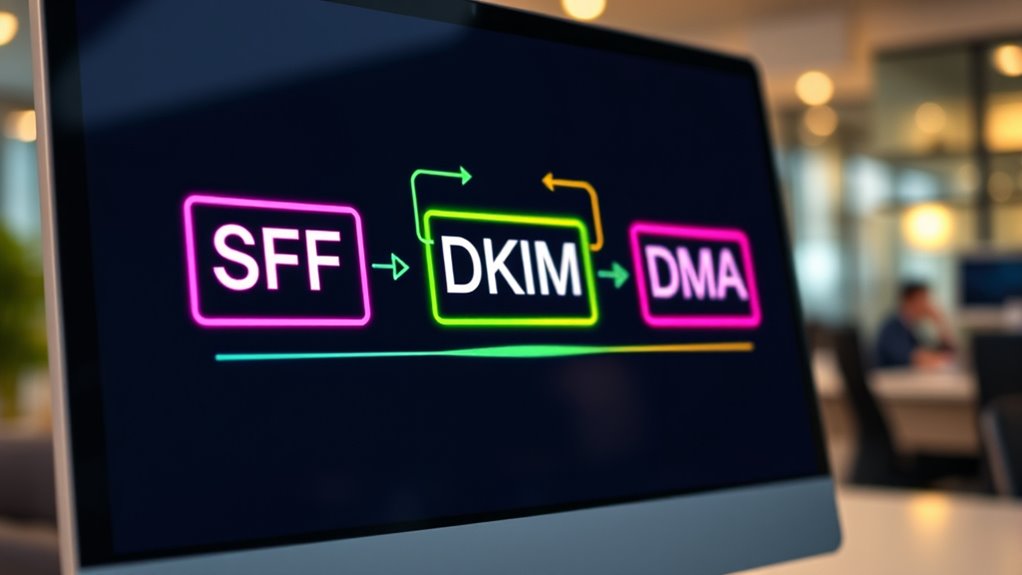To build trust in your email, you need to understand SPF, DKIM, and DMARC. SPF verifies that your emails come from authorized servers, preventing domain spoofing. DKIM adds a cryptographic signature to confirm message integrity and authenticity. DMARC combines both to set policies on how recipients handle unauthenticated messages and provides reporting. Implementing all three strengthens your email security, improves deliverability, and enhances your domain’s reputation—exploring further will show you how these tools work together efficiently.
Key Takeaways
- SPF verifies if emails originate from authorized servers, preventing domain spoofing.
- DKIM adds cryptographic signatures to ensure email integrity and authenticity during transit.
- DMARC sets policies for handling failed SPF or DKIM checks, enhancing domain protection.
- Combining SPF, DKIM, and DMARC strengthens email security and builds sender trust.
- Proper implementation improves email deliverability and reduces spam and phishing risks.

Have you ever wondered how email systems verify that messages truly come from the sender they claim to be? When you receive an email, especially from an unknown sender, it’s natural to question whether it’s legitimate or a potential scam. That’s where email authentication comes into play, helping to confirm the sender’s identity and protect your inbox from phishing and spam. Email authentication isn’t just about security; it also influences domain reputation—the trustworthiness associated with a sender’s domain. A strong domain reputation ensures your emails land in inboxes rather than spam folders, making your communication more effective. Understanding how SPF, DKIM, and DMARC work together can help you build and maintain this trust.
Email authentication verifies sender identity and enhances domain reputation, ensuring your messages reach inboxes securely.
Sender Policy Framework (SPF) is the first line of defense. It’s a simple DNS record that specifies which mail servers are authorized to send emails on behalf of your domain. When an email arrives, the recipient’s email server checks the SPF record to verify if the message was sent from an approved server. If it passes, it signals that the message is likely legitimate, boosting your domain reputation. If it fails, the email might be flagged as suspicious or rejected outright. SPF helps prevent spammers from forging your domain in their malicious messages, maintaining your domain’s credibility.
Next, DomainKeys Identified Mail (DKIM) adds a cryptographic signature to your emails. When you send an email, a private key signs the message, and the recipient’s server uses the corresponding public key stored in your DNS records to verify it. This process confirms that the email hasn’t been altered in transit and genuinely comes from your domain. DKIM strengthens email authentication by ensuring message integrity, which enhances your domain reputation. When recipients see that emails are properly signed, they’re more likely to trust your messages and engage with them.
Finally, DMARC (Domain-based Message Authentication, Reporting, and Conformance) ties everything together. It builds on SPF and DKIM by instructing email servers how to handle messages that fail authentication checks. You can set policies to reject, quarantine, or accept suspicious emails, giving you control over your domain’s reputation. DMARC also provides reports, allowing you to monitor your email traffic and quickly address any abuse or misconfiguration. Implementing DMARC demonstrates that you’re actively protecting your domain, which reassures recipients and improves deliverability. Ensuring proper configuration of these protocols is essential for cybersecurity and maintaining trust in your email communications.
Together, SPF, DKIM, and DMARC form a robust framework for email authentication. They help verify your identity, safeguard your domain’s reputation, and ensure your messages reach the right audience. By properly configuring these protocols, you’re not just protecting your brand; you’re also fostering trust with your contacts, making your email communication more secure and effective.
Frequently Asked Questions
How Do SPF, DKIM, and DMARC Work Together?
You set up SPF, DKIM, and DMARC to strengthen your email authentication and guarantee your messages are trusted. SPF verifies that your server is authorized, DKIM adds a digital signature, and DMARC enforces policies based on your domain alignment. Together, they work seamlessly to prevent spoofing, boost deliverability, and build recipient trust, making your email communication more secure and reliable.
Can These Protocols Prevent All Email Spoofing Attacks?
Sure, these protocols are like your email security superheroes, but don’t get your hopes up—they can’t prevent all spoofing attacks. Email authentication strengthens spoofing prevention, but clever hackers always find new tricks. While SPF, DKIM, and DMARC markedly reduce phishing risks, some sophisticated scams can slip through. So, stay vigilant—these tools help, but they’re not foolproof. Trust, but verify, and keep your defenses sharp.
What Are Common Challenges in Implementing These Protocols?
You’ll face common challenges like misconfiguration challenges, which can cause your email authentication to fail. Ensuring all your servers are correctly set up takes time and technical knowledge. Additionally, user education is vital to prevent accidental bypasses or mistakes. Without proper training, staff might unknowingly weaken your email security. Overcoming these challenges requires ongoing attention, clear documentation, and regular updates to keep your protocols effective and your organization protected.
Did you know that 20% of emails fail delivery due to SPF, DKIM, or DMARC issues? To troubleshoot, start with email header analysis to identify authentication failures. Then, verify your DNS configuration for correct SPF, DKIM, and DMARC records. Make certain these records align with your email server settings. Adjust any misconfigurations, and re-test to confirm proper authentication. This process helps improve your email deliverability and trustworthiness.
Are There Any Costs Associated With Setting up These Email Security Protocols?
Setting up SPF, DKIM, and DMARC usually doesn’t cost much, especially if your email service provider includes them in their package. You might face setup costs if you need expert help or advanced configurations. However, many providers offer these protocols at no extra charge, making them a cost-effective way to improve email security and trust. Always check with your email service to understand any potential setup costs.
Conclusion
Think of SPF, DKIM, and DMARC as your email’s security guard team, working together to keep your messages trusted and safe. When you set them up correctly, you’re building a fortress of trust that keeps imposters out and your reputation intact. Just like a well-guarded castle, your email domain stands strong against threats, ensuring your recipients see your messages as genuine. Protect your email kingdom today and enjoy peace of mind tomorrow.









